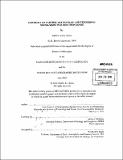| dc.contributor.advisor | Jeffrey J. McGuire. | en_US |
| dc.contributor.author | Llenos, Andrea Lesley | en_US |
| dc.contributor.other | Woods Hole Oceanographic Institution. | en_US |
| dc.date.accessioned | 2010-10-29T18:29:00Z | |
| dc.date.available | 2010-10-29T18:29:00Z | |
| dc.date.copyright | 2010 | en_US |
| dc.date.issued | 2010 | en_US |
| dc.identifier.uri | http://hdl.handle.net/1721.1/59743 | |
| dc.description | Thesis (Ph. D.)--Joint Program in Oceanography/Applied Ocean Science and Engineering (Massachusetts Institute of Technology, Dept. of Earth, Atmospheric, and Planetary Sciences; and the Woods Hole Oceanographic Institution), 2010. | en_US |
| dc.description | Cataloged from PDF version of thesis. | en_US |
| dc.description | Includes bibliographical references. | en_US |
| dc.description.abstract | Large earthquake rupture and triggering mechanisms that drive seismicity in subduction zones are investigated in this thesis using a combination of earthquake observations, statistical and physical modeling. A comparison of the rupture characteristics of M 7.5 earthquakes with fore-arc geological structure suggests that long-lived frictional heterogeneities (asperities) are primary controls on the rupture extent of large earthquakes. To determine when and where stress is accumulating on the megathrust that could cause one of these asperities to rupture, this thesis develops a new method to invert earthquake catalogs to detect space-time variations in stressing rate. This algorithm is based on observations that strain transients due to aseismic processes such as fluid flow, slow slip, and afters lip trigger seismicity, often in the form of earthquake swarms. These swarms are modeled with two common approaches for investigating time-dependent driving mechanisms in earthquake catalogs: the stochastic Epidemic Type Aftershock Sequence model [Ogata, 1988] and the physically-based rate-state friction model [Dieterich, 1994]. These approaches are combined into a single model that accounts for both aftershock activity and variations in background seismicity rate due to aseismic processes, which is then implemented in a data assimilation algorithm to invert catalogs for space-time variations in stressing rate. The technique is evaluated with a synthetic test and applied to catalogs from the Salton Trough in southern California and the Hokkaido corner in northeastern Japan. The results demonstrate that the algorithm can successfully identify aseismic transients in a multi-decade earthquake catalog, and may also ultimately be useful for mapping spatial variations in frictional conditions on the plate interface. | en_US |
| dc.description.statementofresponsibility | by Andrea Lesley Llenos. | en_US |
| dc.format.extent | 116 p. | en_US |
| dc.language.iso | eng | en_US |
| dc.publisher | Massachusetts Institute of Technology | en_US |
| dc.rights | M.I.T. theses are protected by
copyright. They may be viewed from this source for any purpose, but
reproduction or distribution in any format is prohibited without written
permission. See provided URL for inquiries about permission. | en_US |
| dc.rights.uri | http://dspace.mit.edu/handle/1721.1/7582 | en_US |
| dc.subject | Joint Program in Oceanography/Applied Ocean Science and Engineering. | en_US |
| dc.subject | Earth, Atmospheric, and Planetary Sciences. | en_US |
| dc.subject | Woods Hole Oceanographic Institution. | en_US |
| dc.subject.lcsh | Earthquake prediction | en_US |
| dc.subject.lcsh | Earthquake zones | en_US |
| dc.title | Controls on earthquake rupture and triggering mechanisms in subduction zones | en_US |
| dc.type | Thesis | en_US |
| dc.description.degree | Ph.D. | en_US |
| dc.contributor.department | Joint Program in Oceanography/Applied Ocean Science and Engineering | en_US |
| dc.contributor.department | Woods Hole Oceanographic Institution | en_US |
| dc.contributor.department | Massachusetts Institute of Technology. Department of Earth, Atmospheric, and Planetary Sciences | |
| dc.identifier.oclc | 670430128 | en_US |
